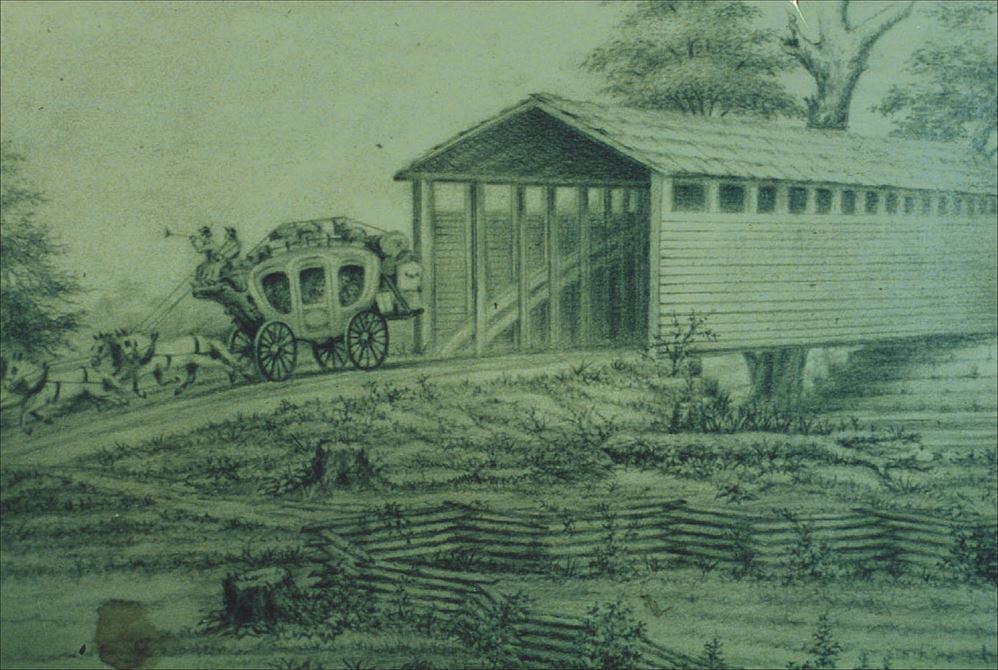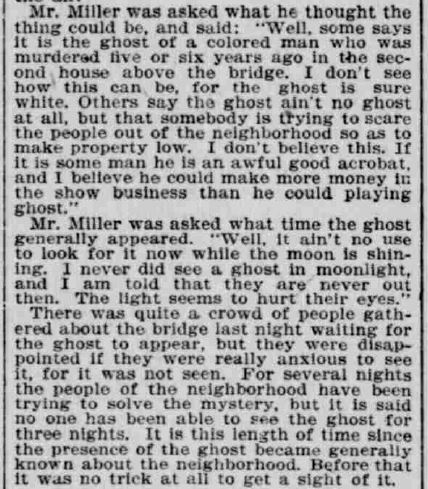When you dig through old newspapers for a living, you find out pretty fast that almost every street corner has an entertaining story and sometimes a haunt or two. Like the once-wild Pogue’s Run, a harnessed underwater ghost that trickles through subterranean Indianapolis, most of these stories are “out of sight, out of mind.”
Here’s a glimpse of the spectral history of the capitol city’s Near East Side.
Pogue’s Run, which in 1914 was re-channeled underground just north of New York Street before it flowed through downtown in tunnels, owes its name to a man who also vanished from sight. Generally considered the first permanent white settler in Marion County, George Pogue, a “broad-shouldered,” dark-haired South Carolinian and blacksmith, was also, according to some accounts, the first recorded murder victim and the only man ever killed by American Indians in Indianapolis.
Settling in this isolated part of the new Hoosier state in March 1819, Pogue built a cabin for his family of seven, roughly where Pogue’s Run goes underneath today’s Michigan and Market Streets. The family’s cabin sat near the old swamp that used to occupy most of the northeast outskirts of downtown. Also called Perkins Run after another early settler who left the area “on account of loneliness,” the old stream in 1819 was wild and often flooded, not the sad open ditch and sewage channel it had become just a few decades later.
As an Indianapolis Journal article from January 5, 1890, reported, around the first of April, 1821, a Delaware or Wyandotte Indian known to whites as “Wyandot John” showed up at the Pogue family’s cabin. Rumor had it that the wanderer was an outlaw among the Delawares. He was probably also a horse thief — one of the worst offenses in those days.
Mrs. Pogue objected to Wyandot John being around the cabin, but the blacksmith gave him breakfast. Some of Pogue’s horses had gone missing, and the visitor told him to go over to a Delaware camp on Buck Creek twelve miles away.
Striking out into the woods, George Pogue, like the creek that still bears his name, never came back. His murdered body may have been sent floating downstream. (In 2013, a jaw bone showed up at Garfield Park, prompting investigators to ask if it was George Pogue’s.)
As the young city grew, the often rampaging creek rapidly came to be considered a “source of pestilence.” Before legislators moved the Indiana capitol north from Corydon in 1825, they allotted $50 to rid Pogue’s Run of mosquitoes, which bred the malaria that killed off many infant towns on the Midwestern frontier. Even as late as the Civil War, what became the Near East Side was thought of as remote from downtown and practically wild country.
***
On May 20, 1863, the creek became the site of the so-called “Battle of Pogue’s Run.” At the Indiana State House, approximately 10,000 Democrats — including Copperheads and suspected members of the pro-Confederate Knights of the Golden Circle — gathered to protest the Lincoln administration. Two months before the Battle of Gettysburg, the war was going badly for the Union, and Lincoln had just passed the Emancipation Proclamation, which angered Southern sympathizers. With tensions running high, a large military force kept an eye on the Democrats downtown. (Under the leadership of Dr. Thomas Bowles, the founder of French Lick, Indiana, the Knights eventually plotted to kidnap Indiana Governor Oliver P. Morton and violently overthrow the state government).
That May, as Union soldiers confiscated pistols from Democrats at the Legislature, the crowd boarded trains to get out of the city. Stopped on the tracks, one train car was raided for weapons. On another, passengers (including many women, whom the Democrats believed wouldn’t be searched) threw somewhere between 500 and 2,000 pistols, rifles, and knives out the train window into the creek. Republicans lampooned it as the “Battle of Pogue’s Run.”
A ghost story from the era appeared in the Indianapolis News on January 29, 1889:
Traditions of a Haunted Elm Tree in the Pogue’s Run Bottoms.
Nowhere on Hoosier soil has nature nourished such giant trees as in the Pogue’s Run bottoms. In the days when trees were not appreciated the hand of the destroyer felled nearly all the great elm, walnut and sycamore peculiar to this district, but here and there a few remain, stately testimonials of the old-time forest grandeur. There are elm trees here and there along the run that are wonders in this day. On East Michigan street, beyond the creek, is one monarch whose branches have a diameter of over a hundred feet, and close to this one is the stump of a burnt-out sycamore, still showing signs of life, in which a family could comfortably live. The interior of the hollow tree is eight feet across in the clear.
But one tree belonging to this group is better known than all the rest. It is sometimes called “hangman’s elm,” sometimes “the gallows tree,” and occasionally the boys of the neighborhood speak of it as “the home of the ghost.”
The neighbors don’t believe in spooks, but somehow or other tradition has handed down a ghost story that will not die. The public records and the memory of the “oldest inhabitant” furnish no evidence on this point, but there is a story in the air to this effect: During the war, one day when there was bloody news from the front, and when human life was cheap, the body of an unknown man was found hanging from this particular tree. Soldiers who climbed the tree to cut down the body found a curiously concealed opening in the tree. It was instantly concluded that the hollow interior of the elm should be the place of sepulture. The body was lowered into the hollow tree, but apparently it struck no bottom. Certainly it gave forth no sound in falling.
It may have been that the dust and accumulation of rotted particles of the tree’s heart had made a soft, deep bed within so that no sound of the falling body came forth. Or was it possible that the spreading roots of the elm walled in a deep “cave of the winds” or well? At any rate nothing was heard when the body tumbled to its uncertain grave.
The spot where the supposed burial tree stood long ago became part of the city. The site is beautiful. Lots have been sold and houses built all about it. A stranger bought the lot on which the tree stands. But he will never build there. One of the neighbors says:
‘From the swaying branches of the old elm come mournful sounds of distress, and many a man passing that way has been horrified at the footfalls of invisible pursuers. Dim figures are sometimes seen in the neighborhood, but these always retrace their cloudy way to the tree and are, as it were, swallowed up by it . . .’
By the 1890s, much of the eleven-mile course of Pogue’s Run was an open, festering sewer pit, clogged with industrial, animal and human waste. Newspaper accounts from the time suggest that one of the most polluted sections of the creek was in the Cottage Home neighborhood just west of the federal arsenal (the building later became Arsenal Tech High School.) In 1897, Indianapolis city commissioners were already considering turning the de facto sewer into a controlled sewage conduit, as the creek “pulled pranks” in the form of deadly floods, doubly disastrous considering the amount of bacterial waste in the water. In 1890, the Journal spoke of its appalling and unsanitary “odoriferous waters,” which boys who “Worked Like Beavers” dammed up to make a swimming hole in 1903 — “for bathing purposes.”
The idyllic landscapes painted by pioneer Hoosier artists Jacob Cox and Christian Schrader show the creek before it was fouled up in the late 1800s.
(Pogue’s Run Swimming Hole by Jacob Cox, 1840s. This spot is now the site of Indianapolis Union Station.)
(This drawing by Christian Schrader shows the Pogue’s Run Covered Bridge, which once sat on the National Road near the intersection of College Avenue and East Washington St.)
Several old-fashioned bridges, made of stone and wood, crossed Pogue’s Run in the 1890s. Stories circulated that at least one of these, at the intersection of Highland Avenue and what used to be called Campbell Street, had a ghost.
The Indianapolis Journal ran the story in 1896. (Campbell was renamed East North Street that September, three months before “The Pogue’s Run Ghost” came out on December 11.) This Gilded-Age paranormal site is at 603 N. Highland Ave., less than a block west of Arsenal Tech’s tennis court.
Could the “specter” have been the fog of the creek — or was it the spooky miasmas of sewage elevating into the air? (That sounds sinister enough to me)!
As far as I can tell, this piece of ghost-lore never showed up again in the city’s newspapers, and might have dropped out of memory altogether when a modern concrete bridge was put here. But maybe Google’s Nine-Eyes sees what we can’t see? Like this blurry spot on the new bridge, captured here in June 2014:
(The Indianapolis News portrayed some of the old stone bridges that once crossed Pogue’s Run in May 1905, on the eve of a dramatic re-engineering project that sent it through tunnels downtown.)
One last, and arguably far more amazing, story :
A few steps south of the “ghost bridge” is a parking lot at 564 N. Highland Avenue. For decades, this was the site of a small shotgun house owned and occupied by Louisa Magruder, daughter of Thomas Magruder, whom many believe to be the inspiration for Harriet Beecher Stowe’s Uncle Tom.
As Joan Hostetler has shown over at HistoricIndianapolis.com, Louisa Magruder lived next to the so-called ghost bridge from the 1870s until her death in 1900 at age 92. The elderly woman must have heard these spooky stories, since she was probably the phantom’s closest neighbor.
Louisa’s land along Pogue’s Run had once been part of a farm and orchard owned by Indiana Governor Noah Noble, whose father kept the Magruders in slavery back in Virginia and Kentucky. The Magruders were freed when the Nobles moved north to Indiana around 1820, though they continued to be employed as servants in the governor’s family. Louisa, who had been a nanny for the Nobles, lived along the creek for almost thirty years after the Civil War.
What might have been the real inspiration for “Uncle Tom’s Cabin” — her father Thomas’ house at the corner of East Market St. and North College Ave. — sat barely a mile southwest of her house in Cottage Home. The novelist Harriet Stowe’s brother, abolitionist Henry Ward Beecher, was a Presbyterian minister in Indianapolis in the 1840s and often visited the Magruder cabin, where he must have known her, and Stowe herself lived in Cincinnati. As pioneer historian J.P. Dunn writes in his 1910 History of Greater Indianapolis: “It is the testimony of the Noble family that ‘Mrs. Stowe was a frequent visitor at Uncle Tom’s cabin, and wrote much of her book there’. . . Uncle Tom had but two children, Moses and his younger sister Louisa, and they were middle-aged people when Mrs. Stowe knew them.”
Concat: staylor336 [at] gmail.com


















